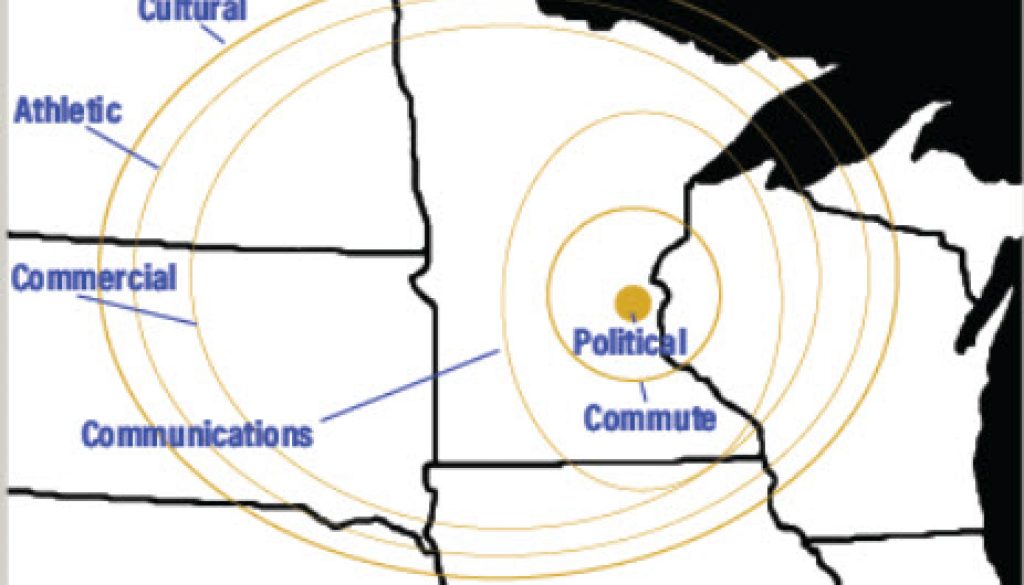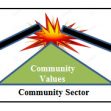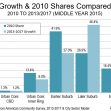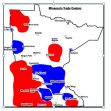Geography of the Smart Region
The Smart Region is based upon a socio-economic-cultural orientation, not a political jurisdiction definition. Communities function within the context of a mutually beneficial relationship to enhance viability for all.
A Historical First
We can live where we want and increasingly bring our jobs with us Gutenberg’s printing press in 1465 changed the world by statically replicating information and laying the groundwork for the Renaissance. Although this was a time of great transformation, knowledge was still limited by time and distance. Five hundred years later the combination of telecommunications and computerization is changing the world by eliminating the impact of time and distance by dynamically providing access to information. The final breakthrough will be when we can penetrate the silos that have been created based upon our legacy organizational structure; they prevent access to knowledge itself.
Policy Continues to Lag Technology; How Can We Align Them?
It may be the challenge of the Age to determine whether computers or change is the number one fear in society at large. Regardless, the human side of understanding the emerging technologic opportunities remain locked in the chains of the status quo. This is a period for redefining our boundaries and the foundations of community relationships in order to optimize their individual viability. For the government boundaries, there are three structural areas of concern:
First– the delivery of government services is best defined by the boundaries of the governmental unit’s jurisdiction. These jurisdictions were defined by glaciers and pioneer surveyors with the county seat often located on the extreme edge of the county. Based upon the Smart Region approach, counties could merge so that the county seat would comply with the dominating trade center in the area and be better situated to serve its constituents.
Second– to promote and create economic prosperity, Minnesota established economic development regions and followed county jurisdictional boundaries; they were required to develop long range plans. However, the state has no such plan that would provide a coordinating context for these plans nor does the state require these regions to coordinate across their boundaries. With no context in common, there can be no plan in common. The Smart Region approach would provide the contextual vision for the Smart Region and ask that the various trade centers within that region develop their own plans both to highlight their unique opportunities as well as how they support the regional vision.
Finally, the metro area dominates state policy and there is no balancing effort. The federal Electoral College could be a model for how this balancing effort could provide a mechanism to support rural interests. The Smart Region approach would evolve this technique as the implementation process proceeds.
Enter the Smart Region
In an approach similar to the geographer John Borchert who defined nested communities based upon relative sales strength, we define the Smart Region based upon the economic, cultural and social orientation to an urban center. For Minneapolis-St Paul, we examined the sales territories of sports teams: Twins and Vikings; cultural organizations: the Guthrie and Ordway theaters; and a generalized boundary for commercial sales territories.
Under this approach, the Minneapolis-St Paul Smart Region embraces Minnesota and approximately half of the two Dakotas, Iowa and Wisconsin; this geographic region becomes an economic entity upon which to compete in the global marketplace. The more uniform the regulations are within this area, the more integrated and stronger the economy will be. This collective community represented by this boundary must be organized to develop a strong vision for the Smart Region. All stakeholders should be represented.
A Strategy for Enhanced Viability
Supporting equal access to technology and opportunity throughout this five-state area is the foundation for all subsequent policies. The urban-rural synergy is both obvious and ignored. Without food and raw materials from the rural economy, the urban areas would struggle; without the economic engine and services found in the urban areas, the rural communities would suffer. And in fact, lacking a full integration strategy, that is what has happened to our rural areas over these past decades.
The Industrial Revolution gave rise to urban growth and 75 years of rural depopulation. The opportunity for repopulation is now before us thanks to the Information Age. This restoration of rural demographic balance is critical…and the opportunity is now. Our institutions must recognize the basic fairness of this concept and engage; to join in the empowerment of the citizen and the resourcefulness of the business community.
Coming up in our next post:
The Community Dialogue Process and Recommendations
Things you can do …
- Read my book: “Slaying the Status Quo”
- Share what you think are the problems we face and how they can be addressed.
- Respond to this post with a comment below.
- Contact me John Sanger by email or phone 651-486-8408
 SmartRegions.US is a community-driven strategy for restoring neighborhood viability by integrating rural-urban economies.
SmartRegions.US is a community-driven strategy for restoring neighborhood viability by integrating rural-urban economies.




